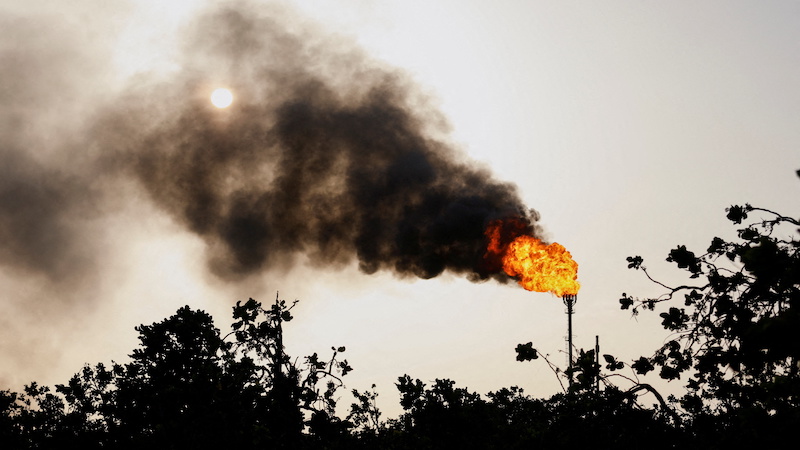Energy analysts have been singing the same tune ad nauseam: cutting climate-harming methane emissions from fossil fuels is one of the simplest and cheapest ways to slow the rate of global warming fast.
But oil, gas and coal producers are still closing their ears. In 2023, they continued spewing near record-high amounts of methane into the atmosphere, according to the latest assessment by the International Energy Agency (IEA) released on Wednesday. That is despite a raft of promises to stop doing so.
Now, however, analysts believe the tide may finally be turning. The introduction of stronger regulations in key fossil fuel-producing and consuming countries, coupled with better monitoring and transparency of harmful leaks, gives them cause for optimism.
“While emissions are still very high, 2024 is going to be a watershed moment on action and transparency on methane,” said Christophe McGlade, head of the IEA’s energy supply unit.
Methane role in 1.5C goal
Methane is a major contributor to global warming. Although it remains in the atmosphere for a much shorter time than carbon dioxide, it is 84 times more potent over a 20-year time horizon.
The energy sector represents the second-largest source of methane emissions linked to human activity, after agriculture, and has the biggest potential for reduction, according to analysts.
“If we can’t make real progress in cutting down methane, it is going to be impossible to limit warming to 1.5C,” said McGlade, referring to the most ambitious warming goal in the Paris Agreement.
The IEA estimates that the fossil fuel industry needs to reduce methane emissions 75% by 2030 for the world to reach net-zero greenhouse gas emissions in 2050.
But last year methane emissions from fossil fuels remained near a record high first reached in 2019, rising slightly from 2022 to 120 million tonnes, according to the watchdog. The United States and China are by far the largest emitters of the powerful gas from oil and gas operations and the coal sector respectively.
Leaks from old or poorly maintained infrastructure and the practice of flaring – burning of excess gas – at oil and gas wells are the main energy-sector culprits for putting methane in the atmosphere.
Easy-fix
Reining in those emissions does not require rocket science. The IEA says well-known technologies and measures, such as upgraded equipment and more efficient practices, can cut the bulk of methane generated from fossil fuels in a fast and cheap way.
Just less than half of last year’s emissions could have been avoided at no net cost to the producers, with measures paying for themselves thanks to revenues from the additional gas captured. “It was a massive missed opportunity,” McGlade said.
Fossil fuel firms seek UN carbon market cash for old gas plants
If this is such a win-win, it begs the question of why fossil fuel producers are not stepping up to the plate. Lack of awareness over the scale of emissions and longer return on investment from plugging leaks are cited in the report as extenuating circumstances.
For Mark Brownstein, methane expert at the Environmental Defense Fund, up until very recently methane had simply been ignored by the global community as a serious threat.
“Aggressive action on methane is long overdue, but we are unfortunately still at a relatively early stage,” he told Climate Home. “Only now we’re starting to see some coordinated action from companies and countries to address this pollutant.”
Raft of pledges
More than 150 countries have signed up to a commitment first announced at the Cop26 climate summit in Glasgow to reduce global methane emissions by at least 30% from 2020 levels by the end of this decade.
Last year’s Cop28 in Dubai produced a host of new promises. The Global Stocktake assessment of national climate plans called for countries to substantially cut methane emissions. Meanwhile, more than 50 oil and gas companies pledged to speed up emission reduction efforts.
But for Romain Ioualalen from campaign group Oil Change International, the industry’s words only go so far. “The climate arsonists fuelling climate chaos cannot be trusted to put out the fire,” he said. “Government must take action to force the industry to clean up its mess on its way out the door.”
New regulations are now in the pipeline and provide experts with the biggest hope that things will finally move in the right direction.
Rules and satellites
In December 2023, the United States finalised new rules aimed at cracking down on U.S. oil and gas industry releases of methane. These include measures to eliminate routine flaring and force producers to better monitor leaks from equipment. Neighbouring Canada has also announced a new proposal for beefed-up methane-cutting standards.
Across the ocean, the European Union agreed at the end of last year on a new law that will require companies to report emissions, monitor and fix leaks, and limit flaring. Crucially, the rules will also apply to imports of oil, gas and coal into the bloc, effectively forcing overseas producers to improve their standards.
Alongside policy developments, the ability to track methane emissions is continuously improving – mainly thanks to satellite technologies – leaving polluters with less room to hide.
Advances on this front are expected to continue in 2024. MethaneSAT, a new satellite developed by EDF, was launched into space in early March and will soon provide free, near-real-time access to methane emissions data from wide areas that have so far been overlooked.
“This data will not only assist in the implementation of regulatory requirements, but it will also underpin the commitments made by fossil fuel companies at Cop28,” said Brownstein. “All of this is finally pointing us in the right direction.”
